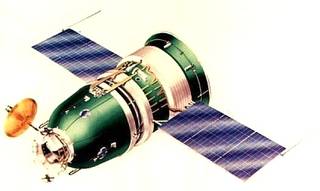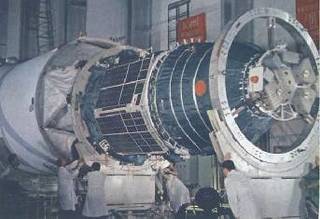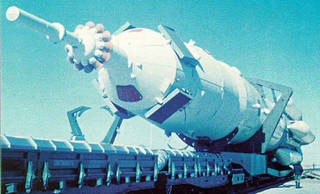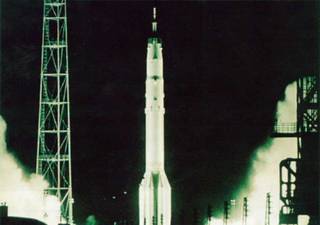50 years ago, on the way to the Moon…..
In the race to fly humans to the Moon in the 1960s, the Soviet Union supported two separate programs, and test missions associated with those programs likely played a role in the decision to send Apollo 8 on its historic first human lunar orbital mission.
One based on the N1 Moon rocket, planned to land a single cosmonaut on the Moon. The other, the L1 program, involved sending two cosmonauts on circumlunar missions without an actual Moon landing. The Soviet government initiated the L1 circumlunar program in 1965, using a spacecraft called Zond (Russian for “probe”), with spacecraft construction beginning a year later. In all, 14 spacecraft were built with initial flights to be unmanned tests; eventually, the Soviets hoped to fly a human circumlunar mission. The Zond essentially was a Soyuz spacecraft with the Orbital Module removed to save weight, replaced with a high-gain antenna and navigation instruments to enable lunar missions. Although it used the greater lift capability of the Proton rocket with a new upper stage to send the spacecraft and two cosmonauts on a free-return circumlunar trajectory, that capability was not enough to actually place the Zond into lunar orbit.
After several failed launch attempts, the Soviets achieved partial success with Zond 4 (Zond 1-3 were unrelated planetary and lunar probes launched in 1964-5). The Zond 4 flight was in some ways similar to the Apollo 4 and 6 missions as they were uncrewed test flights in highly elliptical Earth orbits. The primary objectives of Zond 4 were to test long distance navigation and communications, the heat shield at lunar reentry velocities, including a skip reentry trajectory to reduce aerodynamic stress on the spacecraft (similar to Apollo’s planned reentry scenario), and the recovery systems with a soft landing in Soviet territory.
Zond 4 launched successfully on March 2, 1968, from the Baikonur Cosmodrome in Kazakhstan, and after a short time in a low-Earth parking orbit, the Proton’s upper stage ignited for a second time to send the spacecraft into a highly elliptical Earth orbit. Zond 4 was not planned to fly near the Moon, in fact to minimize trajectory complications from lunar gravity, it was launched in a direction opposite the Moon. Although Zond 4 experienced ongoing intermittent problems with its navigation star tracker, it performed such an accurate mid-course correction on March 6 that no additional adjustments were required. After reaching its apogee at roughly lunar distance, Zond 4 began its long coast back to Earth. On March 9, the Descent Module separated from its other components and began encountering the top layers of the Earth’s atmosphere. At this point, the spacecraft should have used its spin to create aerodynamic lift to temporarily skip out of the atmosphere, before making a second reentry to head for a soft landing in the Soviet Union. But the faulty star tracker failed to properly align the spacecraft, which ended up making a single ballistic entry over the Gulf of Guinea off the coast of West Africa. The spacecraft experienced a deceleration of 20 times Earth gravity, which activated its self-destruct mechanism to prevent it from landing outside Soviet territory and possibly be recovered by unfriendly nations, and also revealing not only the nature of the mission but that it had failed.
Two unmanned circumlunar Zond flights later in the year plus reliable intelligence reports hinting that a Soviet manned circumlunar flight was imminent were factors that played a role in the decision to send Apollo 8 on a lunar orbital mission.



























